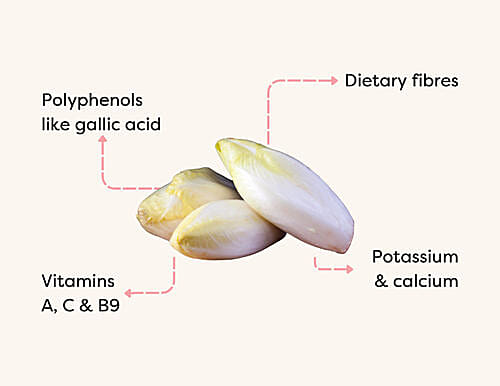Chicory: A good source of fibre, vitamin C and polyphenols
15th Mar 2024
Chicory’s crisp, tangy leaves add crunch and a hint of bitterness to meals. Rich in fibre, vitamin C and polyphenols like quercetin, it supports digestion and heart health.
Key points
Source of
Chicory leaves are packed with:
- Fibre to support digestion and a healthy gut microbiome.
- Polyphenols, like gallic acid and quercetin.
- Vitamins A, C, and B9 (folate).
- Minerals, including potassium, calcium and phosphorus.

Health benefits of chicory
Eating more leafy greens, like chicory, has been linked to:
- Living longer – Lower all-cause mortality.
- Heart health – Lower risk of cardiovascular disease.
- Brain health – A small study found leafy greens may slow down age-related cognitive decline.
Mix up your greens: Chicory is another leafy vegetable to add to your meals – mix it up with all the leafy greens you can find like spinach, kale, collards and mustard greens.
Endive vs chicory – What’s the difference?
They’re often mixed up and no wonder with so many names across Europe. Both belong to the daisy family, but here’s the difference:
- Chicory is a perennial plant with varieties like red radicchio, green Sugar Loaf, and pale yellow Belgian chicory, also called Belgian endive.
- Endive is an annual leafy green, including escarole and curly frisée.
In cooking they’re all treated as bitter greens, perfect for adding flavour and crunch to your meals.
Traditional uses
Bitter herbs like chicory have been used in herbal medicine for centuries. They’re valued for supporting digestion, easing constipation and improving liver function. Chicory has also been traditionally used to help with rheumatic complaints. Historically, the ancient Egyptians grew chicory as a medicinal plant, and its therapeutic benefits have stood the test of time.
5 ways to enjoy chicory
- Raw in a salad – It adds a nice bitter kick. Mix it with milder greens like spinach, throw in some nuts, cheese or fruit and drizzle on a sweet dressing.
- Sautéed or grilled – Cook it up with olive oil, garlic and a salty ingredient like capers or anchovies.
- In soups, stews or pasta – Toss it in for extra flavour and texture.
- As a snack – Use the sturdy leaves of Belgian endive as veggie scoops for hummus, blue cheese dip or whatever you love.
- In sandwiches or wraps – Adds a bit of crunch and a hint of bitterness to lift your favourite fillings.
Around the world
- In northern Europe, chicory is traditionally wrapped in ham, smothered in a creamy béchamel sauce, sprinkled with cheese and baked until golden and bubbly, like Dutch Witlof met Ham en Kaas.
- In France and Belgium, you can find it in an Endive Salad with Roquefort, combined with blue cheese, toasted walnuts and a vinaigrette.
- In Italy, it’s mixed with beans, garlic and olive oil in Cicoria e fagioli.
- Access over 800 research backed recipes
- Personalise food for your unique health needs
